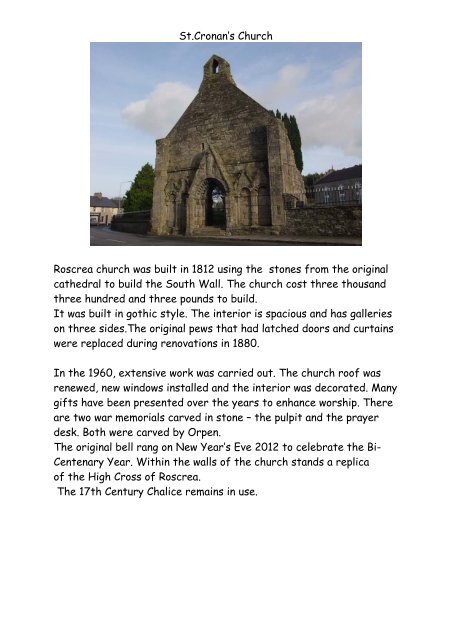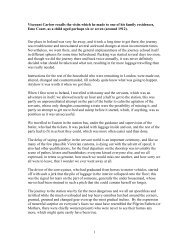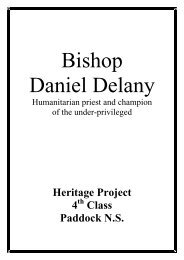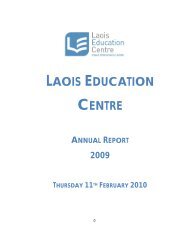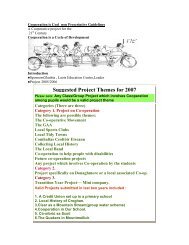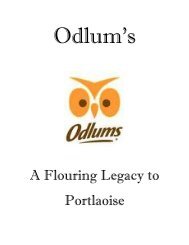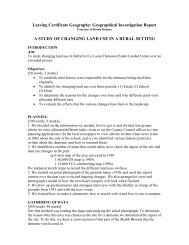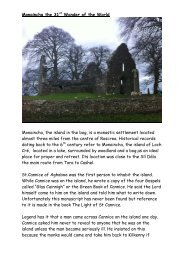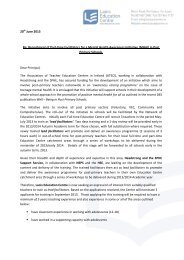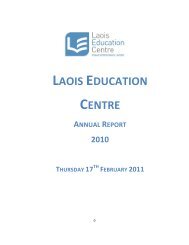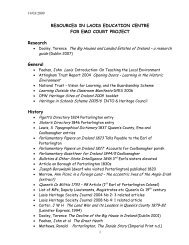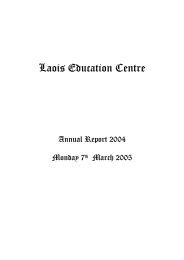St Cronan - Laois education Centre
St Cronan - Laois education Centre
St Cronan - Laois education Centre
You also want an ePaper? Increase the reach of your titles
YUMPU automatically turns print PDFs into web optimized ePapers that Google loves.
<strong>St</strong>.<strong>Cronan</strong>’s ChurchRoscrea church was built in 1812 using the stones from the originalcathedral to build the South Wall. The church cost three thousandthree hundred and three pounds to build.It was built in gothic style. The interior is spacious and has gallerieson three sides.The original pews that had latched doors and curtainswere replaced during renovations in 1880.In the 1960, extensive work was carried out. The church roof wasrenewed, new windows installed and the interior was decorated. Manygifts have been presented over the years to enhance worship. Thereare two war memorials carved in stone – the pulpit and the prayerdesk. Both were carved by Orpen.The original bell rang on New Year’s Eve 2012 to celebrate the Bi-Centenary Year. Within the walls of the church stands a replicaof the High Cross of Roscrea.The 17th Century Chalice remains in use.
<strong>St</strong> <strong>Cronan</strong><strong>St</strong>. <strong>Cronan</strong> was born in the sixth century AD.He is believedto have been a native of Roscrea.<strong>St</strong>. <strong>Cronan</strong> was educated at Clonmacnoise one of Ireland’s leadingmonasteries under the <strong>education</strong> of <strong>St</strong>.Kieran.His first foundation in the Roscrea area was a cell which he builtnear Loch Cré in a woody place which is now known as Sean Ross.
He laboured there for many years where the poor came to him foralms, the distressed for comfort and the homeless for shelter.But Sean Ross was an isolated area, away from the main road, theSlí Dála and the travellers seeking <strong>St</strong>.<strong>Cronan</strong>’s hospitality oftencouldn’t find him.History tells us that one winter’s day a party travelling along themain road and intending to lodge at Sean Ross completely losttheir way. After a trying time <strong>St</strong>.<strong>Cronan</strong> found them at the placewhere they rejoined the main road. There <strong>St</strong>.<strong>Cronan</strong> decided tostay and so abandoned his cell at Sean Ross and built a bigger andbetter foundation in this more accessible position near the SlíDála and the Moinín River . This cell is what is now called RoscreaMonastery. Unfortunately, little remains today.The original structure would have been wooden. From the recentexcavations show that it’s layout was similar to other monasteries.The area around what used to be Roscrea Monastery is the sitewhich is known today as Church <strong>St</strong>reet. On this site today wehave lots of historic buildings, such as the round tower, the westgable end , Black mills, also in 2010 there was an archaeologicaldig carried out on the site of where Tesco is today. Thearchaeologists found coins, teeth and animal remains.
Round TowerThe Irish reacted to the invasions by constructing high round towersto be used as places of refuges during the raids. A series of towerswere built throughout the land until recently it was generallyaccepted that Roscrea’s Round Tower was built in the 10thcentury for this purpose. However,new theories now suggest that thetower may not have been built until a later date.Suggestions now include that it was built in the 12th century as a belltower for the new cathedral.It is located on the west side of Church <strong>St</strong>reet. It faces <strong>St</strong>.<strong>Cronan</strong>’s Church of Ireland.There are architectural similarities between Roscrea and ClonfertCathedrals. Perhaps, the clergy from both dioceses held discussionsabout designs for the Round Tower. The sailing ship was used asa tribute to Brendan the Navigator the Patron of Clonfert!Inside the window of the Tower in Roscrea was a carving of a onemasted sailing ship. This is carved in bold relief. It is about a footlong. The tower still stands, now sixty feet high.The top twenty feet,the conical stone top, of the tower was blown off during the 1798Rebellion by someone firing from a cannon from the Norman Castleon Castle <strong>St</strong>reet.It is thought that the top was wooden.Large sized stones were usedin the construction of the tower is very impressive. Inside is now
only a shell but formally there was three stories. It was inhabited upto the 19th centuryFranciscan FriaryDuring the late 15th century the Franciscan Religious Orderestablished themselves in Roscrea. The order was founded by <strong>St</strong>Francis of Assisi in England around 1210.The Friary was sponsored bythe O’Carroll family, Lord of Eli. The Normans welcomed the neworder as it would help them regain their influence on theecclesiastical matters in the area. The life of the monastery wasshort as it was disbanded following the Dissolution Policies of the16 th Century.The friary in Roscrea was one of the last religious buildings builtbefore the Reformation. The belfry was added at a later date. Theruins of the friary remain today at Abbey <strong>St</strong>reet.


